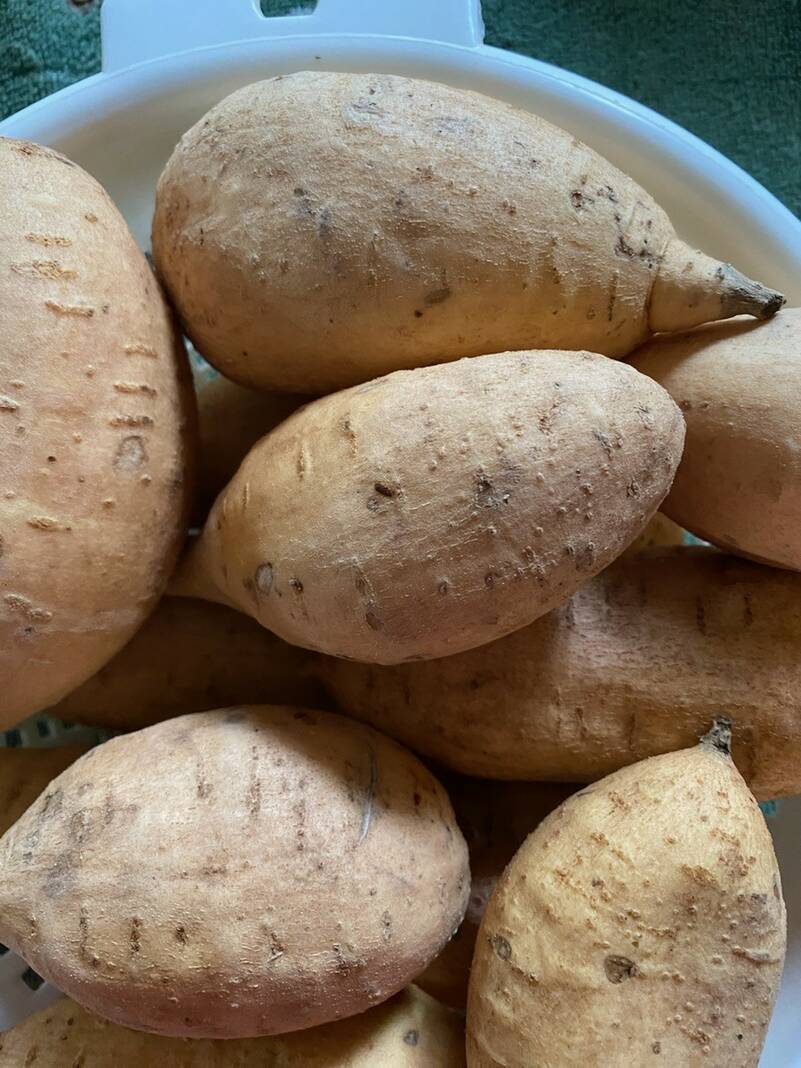Sweet potatoes (Ipomoea batatas) produce a storage root that has a generous amount of Beta carotene, which our bodies convert to vitamin A. This root vegetable is very sensitive to cold. It is commonly treated as an annual and fresh transplants, called slips, are planted each year. In the Rio Grande Valley, planting is usually between March 15 and May 1. This plant thrives under warm conditions and will die off in a freeze. Texas is the fifth largest producer of this nutritious root in the United States.
The plant is a perennial and, if protected from the cold, can live for many years. It is easy to grow, and it is easy to make new plants by cutting a tuber lengthwise and placing it face down in moist potting soil or sand. New plants develop within a couple of weeks, and these can be cut into smaller transplants and the cycle continues. There are several videos of this process on YouTube. Consistent moisture in well drained soil is most important especially during the first 60 days. From planting to harvesting the roots takes about 80 to 120 days, depending on the variety.
There are some Japanese varieties that have gained popularity in recent years.
The sweet potato root is high in fiber, beta carotene, potassium and vitamin C, Niacin, and vitamin B6. A cup of chopped sweet potato also contains 2% protein, and it is high in manganese, copper and potassium with only 180 calories and 41 grams of carbs. The most nutritious varieties are the orange or purple ones. All this fiber and antioxidants support gut health, brain health, our immune systems and our eye health.
 Sweet potatoes are easy to grow, high in fiber and low in calories. (Courtesy photo)
Sweet potatoes are easy to grow, high in fiber and low in calories. (Courtesy photo)The leaves, or sweet potato greens, also contain high amounts of vitamin A and vitamin C (about three times higher than the root), as well as iron and caffeoylquinic acid that controls hypertension and supports heart health. The leaves are very similar to spinach and can be cooked in the same way. They can also be enjoyed raw in salads and in smoothies. Prepare the leaves with olive oil or avocado oil for the highest absorption rates.
So, for year-round production, plant some to harvest the roots in late summer, early fall, and keep some plants protected from the cold, in containers, where they can be brought inside. From the overwintered plants, you can harvest nutritious greens. And, because you are harvesting the greens, these plants are not going to produce the storage roots. This double duty plant is truly worth the effort to have so much nutrition available most of the year.
Roots are sensitive to injury, so be careful when digging them up. Do not bruise the storage root with a shovel. Leave the soil on them and place them in a dry area for a couple of weeks. Then, if possible, bring them inside and store at 55 to 60 degrees F. This process increases the sugars in the root.
The Farmers Market at Firemen’s Park will have fresh sweet potatoes this Saturday, Sept. 7, along with handouts on growing sweet potatoes and recipes to enjoy them. This farmers market is the oldest market in Hidalgo County, and it is in McAllen’s Firemen’s Park, under the large, covered area, next to Town Lake. The summer hours are 8:30 to 11:30 a.m., every Saturday, at 201 N. 1st St. For information on the market, call (956) 330-6410.
Barbara Storz is a horticulturist writing about plants that grow well in the Rio Grande Valley. You can follow her on Facebook.
The post Sweet potato: A double duty plant appeared first on MyRGV.com.
 (2).png)
 1 week ago
27
1 week ago
27








 English (US)
English (US)